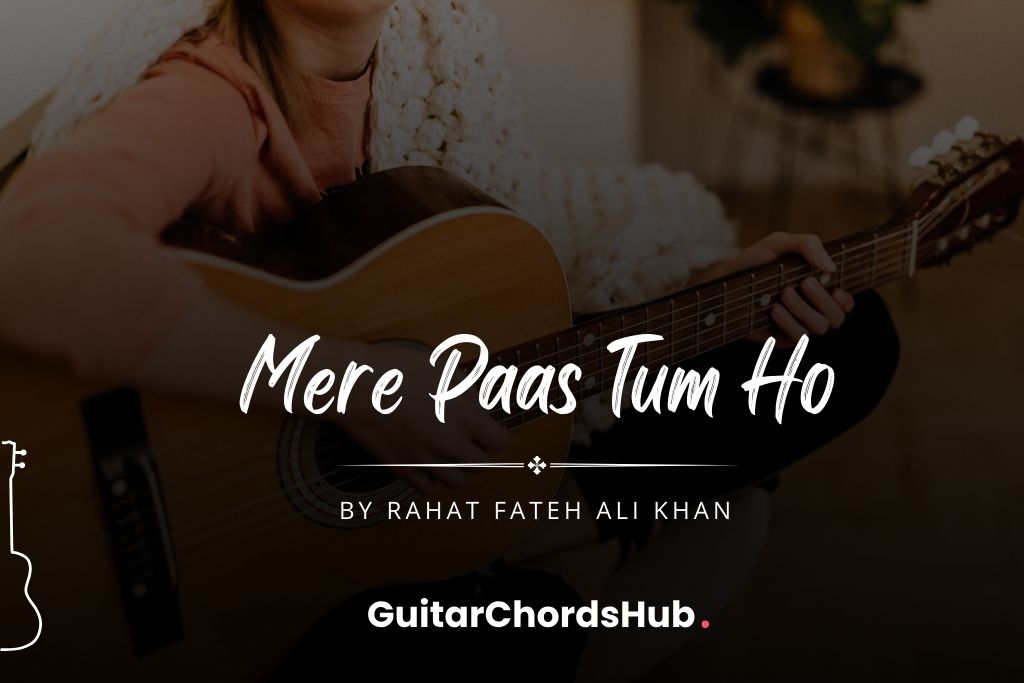By Rahat Fateh Ali Khan
Introduction:
“Mere Paas Tum Ho,” sung by Rahat Fateh Ali Khan, is a profoundly moving song that explores the pain of separation and loss. The lyrics poignantly depict the singer’s struggle to accept the end of a relationship, clinging to lingering memories and unspoken regrets. The melody perfectly captures the raw emotion and deep sorrow expressed in the lyrics.
Guitar Chords for Mere Paas Tum Ho:
This arrangement uses D major (D), Gm (G minor), G major (G), Em (E minor), A# major (A#), C major (C), and Bm (B minor).
(Verse 1)
[D] Bhool Janey Ka Hunar
[D] Mujh Ko Sikhatey Jao
[Gm] Ja Rahey Ho Too Sab Hi Naqsh
[D] Mitatey Jao
(Chorus)
[G] Chalo Rasman Hi Sahi
[Em] Mud K Mujhey Dekh Too [D] Lo
[Gm] Todtey Todtey Ta[A#] lluq Ko
Nibha [D] tey Jao
(Verse 2)
[D] Hmm..Hmm..
[D] Kabhi Kabhi Yeh Mujhey Sataye
[C] Kabhi Kabhi Yeh [D] Rulaye
[D] Kabhi Kabhi Yeh Mujhey Sataye
[Gm] Kabhi Kabhi Yeh [D] Rulaye
[D] Faqat Mere [Gm] Dil Se [D] Utar Jaiye Ga
[D] Faqat Mere [Gm] Dil Se [D] Utar Jaiye Ga
[C] Bichadna [A#] Mubarak,
[C] Bichad Jai [D] ye Ga
(Verse 3)
[D] Kabhi Kabhi Yeh Mujhey Sataye
[Gm] Kabhi Kabhi Yeh [D] Rulaye
[D] Main Samjha Tha Tum Ho
[Bm] Too Kia Aur Mangun
[G] Meri Zindagi Main
[A#] Meri Aas [D] Tum Ho
[D] Main Samjha Tha Tum Ho
[Bm] Too Kia Aur Mangun
[G] Meri Zindagi Main
[A#] Meri Aas [D] Tum Ho
[D] Ye Duniya Nahi Hai Mere Paas To Kya
[C] Mera Yeh [A#] Bharam Tha
[C] Mere Paas [D] Tum Ho
(Verse 4)
[D] Magar Tum Se [Gm] Seekha
[D] Muhabbat Bhi Ho Too
[C] Dagha Kiji [A#] ye Ga
[C] Mukar Jai [D] ye Ga
[D] Hmm..Hmm..
[D] Tera Haath Kal Tak
[D] Mere Haath Main Tha
[D] Tera Dil Dhadkta Tha Dil Mai Hamare
[D] Yeh Makhmoor [Gm] Aankhain
Jo [D] Badli Hoe Hain
[C] Kabhi Hum Ne [A#] Inke Hai [C] Sadqe [D] Utare
[D] Kahin Ab [Gm] Mulaqaat [D] Hojaye Hum Se
[C] Bacha Kar [A#] Nazar Ko
[C] Guzar Jaai [D] ye Ga
Jeena [Bm] Hai, [G] Tere Bina
Jeena [Bm] Hai, [G] Tere Bina
[C] Jeena Hai Ab Mujh Ko [D] Terey Bina
Tips for Playing Mere Paas Tum Ho on Guitar:
- Chord Changes: The song’s emotional impact hinges on smooth chord transitions. Practice each transition methodically to ensure cleanliness and fluidity.
- Strumming Pattern: A consistent strumming pattern works best, but be mindful of using variations to accentuate certain phrases or heighten emotional peaks. Pay attention to the dynamics and feeling of the strumming, adjusting the intensity accordingly.
- Tempo: Maintain a steady, melancholic tempo. Avoid rushing; let the notes and the emotion resonate.
- Dynamics: Use dynamics to create emotional depth. Softer strumming during the verses creates intimacy, while a slightly more forceful strumming for the chorus amplifies the intensity and heartbreak.
Conclusion:
“Mere Paas Tum Ho” is a song that deeply resonates with the listener. With precise chord changes, subtle dynamic variations, and a consistent tempo, you can render a performance that transmits the beautiful melancholy and profound sorrow expressed in this moving classic.



